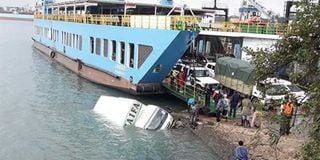An explainer on how to survive a sinking vehicle

The partially submerged lorry which plunged into the Indian Ocean on July 23, 2019. According to Irish Water Safety, it is possible to survive even after your vehicle has submerged in water. PHOTO | FILE | NATION MEDIA GROUP
What you need to know:
- According to Irish Water Safety, it is possible to survive even after your vehicle has submerged in water.
- Panicking is counter intuitive, but avoiding it helps keep a level head to enable you take deliberate life saving actions.
Sunday’s tragedy in which a mother and her daughter drowned in the Indian Ocean after their vehicle rolled off the ferry at the Likoni crossing has raised many questions.
Was the car properly parked and switched off?
Was the ferry faulty?
What else could be done to save the two innocent lives from a scary and painful death?
The jury is still out there on who, the driver or the ferry services, carries the blame on why the vehicle reversed into the water.
VIDEO FOOTAGE
However, from video footage taken by onlookers at the time of the incident, it was evident that with some training and knowhow, the mother and child could have escaped death.
According to Irish Water Safety, it is possible to survive even after your vehicle is submerged in water.
In the website, a guide on what to do in the event a vehicle you are in starts sinking in water has been given.
Utmost importance has been given to quick action given the air supply of the passengers is quickly diminishing and the chances of survival increase if the vehicle is still afloat.
Stay calm – it is important to remain calm and avoid panicking if the vehicle you are in gets immersed in water. It is counter intuitive but it helps you keep a level head and able to take more deliberate and life saving actions.
Unfasten your seat belt and that of children in the vehicle. Prepare the children to be ready to get out
Do not use your mobile phone – do not attempt to call family members or emergency services. The time it takes to operate the phone will cut your chances of survival significantly. You are the only help that you may get at that time.
Open a window. Electric windows may work for some time before the vehicle completely submerges in water. If it does not work, pull out the headrest from the seat and use the metal parts to break open the window. Try to open the windows before the vehicle is completely submerged as the forces of the waves and water will make it more difficult to open.
If windows cannot be opened, exit is still possible through a door. To open the door, however, requires a lot of strength as there will be counter pressure from the water. If the car is still afloat up to this point, opening the door will lead to an increased rate of sinking as more water rushes into the vehicle.
To exit the car, the strongest swimmers should come out first. They should grab onto the roof of the car and come out backwards, head first, face up and pull themselves out. They should then assist weaker swimmers or children out of the vehicle.
Once out of the car, assess whether it would be safe to swim for dry land. If the vehicle is in shallow water and still floating, you could get on the roof and wait for help.
Do not try to save anything from the vehicle such as money, electronics or other valuables.
If you happen to witness a vehicle sinking in a water body nearby, here is a list of what you can do to help the passengers.
Call an emergency rescue service
Depending on how close you are to the vehicle and the surroundings, you can try and pull the floating vehicle closer with the aim of getting the passengers out.
In case passengers cannot open the doors or windows, get a heavy object such as a stone and use it to break the window.
Further action to be taken should depend on the surrounding of the vehicle and the level of competency of the rescuers.




